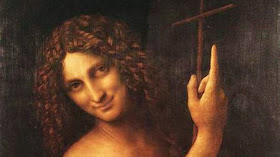Scene of John the Baptist's Early Life and Why He Carried a Cross
John the Baptist is one of the most meteoric characters in biblical history. Only one scene in his life can be identified with certainty, and that is the grim castle beside the Dead Sea, where he fell a victim to Herod's passion and fear. Apparently a large part of his early life was spent at or near Jerusalem, where his father ministered as priest and where he was able to observe the crimes of the people, against which he later so vehemently and effectively[243] protested. The wild, treeless wilderness that runs up from the Dead Sea almost to the gates of Jerusalem furnished a fitting setting for this stern prophet of righteousness, this herald of a new order. Here, undisturbed by the distracting life of the city, he could effectively deliver his message to the thoughtful ones who sought him in his solitude. Here also dwelt that peculiar Jewish sect, the Essenes, whose ascetic life and strict ceremonial régime were an extreme protest against the corrupt Hellenizing tendencies of the day.
The most common use of the cross (pre-Jesus) was as a Sun or Fire symbol. The crossed sticks representing fire making. "Fire" was symbolic of "redemption," or "purification" that was part of the baptismal ceremony.
Why Does John the Baptist Carry a Cross Before the Crucifixion of Christ?
John the Baptist is one of the most meteoric characters in biblical history. Only one scene in his life can be identified with certainty, and that is the grim castle beside the Dead Sea, where he fell a victim to Herod's passion and fear. Apparently a large part of his early life was spent at or near Jerusalem, where his father ministered as priest and where he was able to observe the crimes of the people, against which he later so vehemently and effectively[243] protested. The wild, treeless wilderness that runs up from the Dead Sea almost to the gates of Jerusalem furnished a fitting setting for this stern prophet of righteousness, this herald of a new order. Here, undisturbed by the distracting life of the city, he could effectively deliver his message to the thoughtful ones who sought him in his solitude. Here also dwelt that peculiar Jewish sect, the Essenes, whose ascetic life and strict ceremonial régime were an extreme protest against the corrupt Hellenizing tendencies of the day.
The most common use of the cross (pre-Jesus) was as a Sun or Fire symbol. The crossed sticks representing fire making. "Fire" was symbolic of "redemption," or "purification" that was part of the baptismal ceremony.

